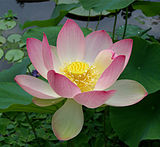- Brine pool
-
 NOAA rendering of a brine pool in the Gulf of Mexico.
NOAA rendering of a brine pool in the Gulf of Mexico.
 Chimaeridae fish and seep mussels at edge of brine pool.
Chimaeridae fish and seep mussels at edge of brine pool.
Brine pools are large areas of brine on the ocean basin. These pools are bodies of water that have a salinity three to five times greater than the surrounding ocean. For deep-sea brine pools, the source of the salt is the dissolution of large salt deposits through salt tectonics. The brine often contains high concentrations of methane, providing energy to chemosynthetic animals that live near the pool. These creatures are often extremophiles.[1][2] Brine pools are also known to exist on the Antarctic Shelf where the source of brine is salt excluded during formation of sea ice. Deep-sea and Antarctic brine pools can be toxic to marine animals.
Characteristics
Brine pools are sometimes called seafloor "lakes" because the dense brine does not easily mix with overlying seawater. The high salinity raises the density of the brine, which creates a distinct surface and shoreline for the pool.[3] When submarines dive into brine pools, they float on the brine surface due to the high density. The motion of a submarine can create waves across the brine-seawater interface that wash over the surrounding "shoreline." [4]
Support of life
Deep sea brine pools often coincide with cold seep activity. Methane released by the seep is processed by bacteria, which have a symbiotic relationship with seep mussels living at the edge of the pool. This ecosystem is dependent on chemical energy, and unlike almost all other life on Earth, has little dependence on energy from the sun.[5]
References
- ^ Extremophile life near brine pools
- ^ Eder, Wolfgang, Jahnke, Linda L., Schmidt, Mark, and Huber, Robert. Applied and Environmental Biology, 17 April 2001. "Microbial Diversity of the Brine-Seawater Interface of the Kebrit Deep, Red Sea, Studied via 16S rRNA Gene Sequences and Cultivation Methods". Accessed 10 August 2010. http://www.ncbi.nlm.nih.gov/pmc/articles/PMC92984
- ^ NOAA exploration of a brine pool
- ^ "The Deep" (2006), Documentary, National Geographic Channel
- ^ World Wildlife Fund. "Deep sea ecology: hydrothermal vents and cold seeps." March 23, 2006. Accessed October 3, 2007.
Ponds - Ash pond
- Balancing pond
- Ballast pond
- Beel
- Cooling pond
- Detention pond
- Dew pond
- Evaporation pond
- Garden pond
- Ice pond
- Immersion pond
- Kettle pond
- Melt pond
- Mill pond
- Raceway pond
- Retention pond
- Sag pond
- Salt evaporation pond
- Sediment pond
- Settling pond
- Solar pond
- Stabilization pond
- Stepwell
- Stew pond
- Stormwater management pond
- Polishing pond
- Tailings pond
- Tarn
- Treatment pond
- Waste pond

Pools Puddles Biota - Beaver pond
- Common pond skater
- Common puddle frog
- Duck pond
- Fish pond
- Goldfish pond
- Koi pond
- Lotus
- Pond heron
- Pond lily
- Pond snail
- Pond turtle
- Pondweed
Ecosystems - Freshwater ecosystem
- Lake ecosystem
- Lentic ecosystem
- Pond ecosystem
Related topics - Aerated pond
- Bakki shower
- Big fish–little pond
- Body of water
- Full pond
- Hydric soil
- Phytotelma
- Pond aeration
- Pond of Abundance
- Pond liner
- Ponding
- The Pond
- Puddle (M C Escher)
- Spring
- Swimming hole
- Water garden
- Water Lilies (Monet)
- Water well
Categories:
Wikimedia Foundation. 2010.

